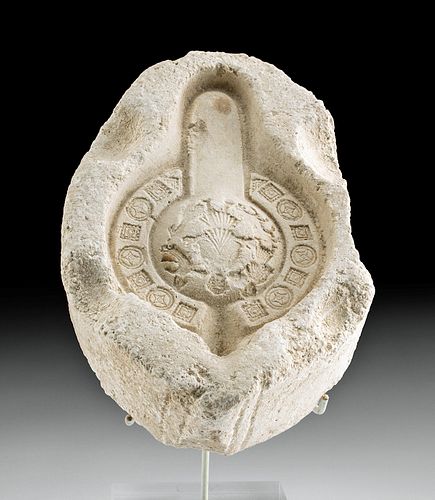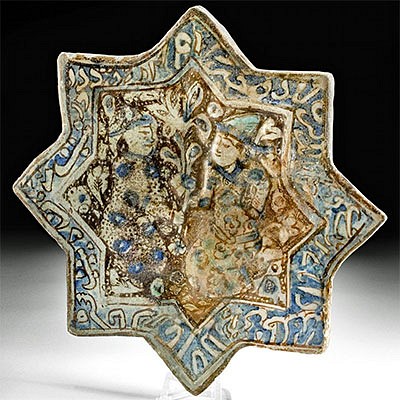Roman Gypsum Oil Lamp Mold w/ Daniel in the Lion's Den
Lot 56
About Seller
Artemis Fine Arts
686 S Taylor Ave, Ste 106
Louisville, CO 80027
United States
Selling antiquities, ancient and ethnographic art online since 1993, Artemis Gallery specializes in Classical Antiquities (Egyptian, Greek, Roman, Near Eastern), Asian, Pre-Columbian, African / Tribal / Oceanographic art. Our extensive inventory includes pottery, stone, metal, wood, glass and textil...Read more
Estimate:
$3,500 - $5,250
Absentee vs Live bid
Two ways to bid:
- Leave a max absentee bid and the platform will bid on your behalf up to your maximum bid during the live auction.
- Bid live during the auction and your bids will be submitted real-time to the auctioneer.
Bid Increments
| Price | Bid Increment |
|---|---|
| $0 | $25 |
| $300 | $50 |
| $1,000 | $100 |
| $2,000 | $250 |
| $5,000 | $500 |
| $10,000 | $1,000 |
| $20,000 | $2,500 |
| $50,000 | $5,000 |
| $100,000 | $10,000 |
| $200,000 | $20,000 |
About Auction
By Artemis Fine Arts
May 20, 2021
Set Reminder
2021-05-20 10:00:00
2021-05-20 10:00:00
America/New_York
Bidsquare
Bidsquare : Ancient & Ethnographic From Around The World
https://www.bidsquare.com/auctions/artemis-gallery/ancient-ethnographic-from-around-the-world-6979
Ancient art from Egypt, Greece, Italy and the Near East, as well as Asian, Fossils, Pre-Columbian, Native American, African / Tribal / Oceanic, Fine art, and much more! All categories, all price ranges... all legally acquired and guaranteed to be as described or your money back. Artemis Fine Arts info@artemisgallery.com
Ancient art from Egypt, Greece, Italy and the Near East, as well as Asian, Fossils, Pre-Columbian, Native American, African / Tribal / Oceanic, Fine art, and much more! All categories, all price ranges... all legally acquired and guaranteed to be as described or your money back. Artemis Fine Arts info@artemisgallery.com
- Lot Description
Roman North Africa, Carthage, Imperial to Byzantine Period, ca. 4th to 6th century CE. A remarkable find, this richly ornamented and fantastically preserved gypsum tool served as the mold for the top half of an ancient oil lamp bearing a depiction of Daniel in the Lion's Den. Enveloped by a repeated pattern of alternating square and circle motifs, the beardless Daniel wears a mandye, or a pleated, belted tunic with a short cape, as he bends both arms at his elbows and holds out his hands. At his feet lie two defeated lions, while an angel flies towards him on his left and the prophet Habakkuk proffers a loaf of bread to his right. These are both direct references to the Book of Daniel in the Old Testament, in which Daniel is thrown into a lion's den for praying to the God of Abraham and is then saved by an angel who closes the jaws of the lion. Habakkuk, who is in Judea making a stew, is instructed by an angel to bring food to Daniel and transported by the angel to the den in Babylon to give Daniel the food. A wonderful utilitarian example from Roman North Africa, rich with religious iconography! Size: 7.25" L x 5.125" W x 2" H (18.4 cm x 13 cm x 5.1 cm); 8.75" H (22.2 cm) on included custom stand.
A terracotta oil lamp made from this mold or one identical to it was published in "A Mosaic of Daniel in the Lions’ Den from Borj el Youdi (Furnos Minus) Tunisia: The Iconography of Martyrdom and the Arena in Roman North Africa" by Angela Kalinowski in "Antiquites africaines" 53 (2017): 115-128, figure 4.
Provenance: private Vero Beach, Florida, USA collection since about 1980
All items legal to buy/sell under U.S. Statute covering cultural patrimony Code 2600, CHAPTER 14, and are guaranteed to be as described or your money back.
A Certificate of Authenticity will accompany all winning bids.
We ship worldwide and handle all shipping in-house for your convenience.
#163783Chips to peripheries of stone and another to spout area. Some abrasions, nicks, and softening of detail throughout. Otherwise, excellent with light earthen deposits in recessed areas.Condition
- Shipping Info
-
All shipping is handled in-house for your convenience. Your invoice from Artemis Gallery will include shipping calculation instructions. If in doubt, please inquire BEFORE bidding for estimated shipping costs for individual items.
-
- Buyer's Premium



 EUR
EUR CAD
CAD AUD
AUD GBP
GBP MXN
MXN HKD
HKD CNY
CNY MYR
MYR SEK
SEK SGD
SGD CHF
CHF THB
THB













